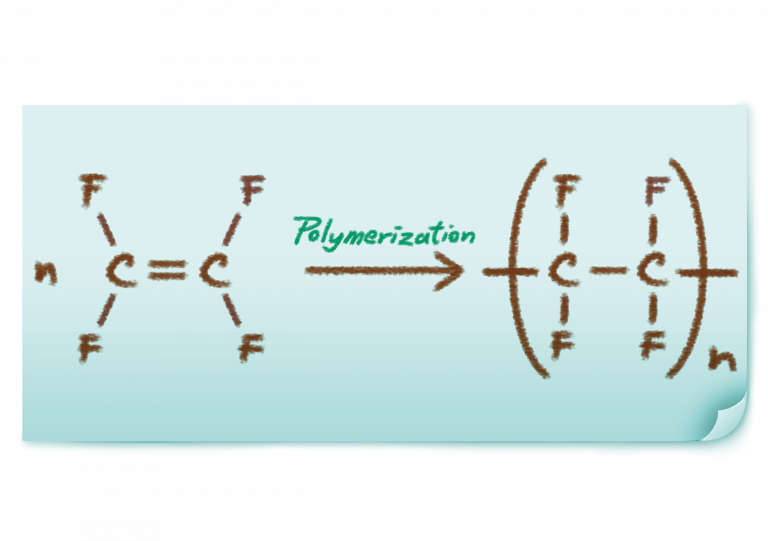
By Henry Lau 劉以軒
Life rarely goes according to plan. The same can be said for science. As scientists have painfully learned (and will continue to learn), more often than not, it takes a few tries to get your expected experimental results. But sometimes, unexpected results turn out to be the best results. Such is the case of one Dr. Roy J. Plunkett, the inventor of TeflonTM, which you may know to be a key component of non-stick frying pans. This is the story of how an experimental blunder turned into a scientific wonder. Stick around to find out more!
You may have heard of TeflonTM before. Scientifically called polytetrafluoroethylene (PTFE), it is a polymer made up of identical repeating “monomer” units joined together. The monomer in question is called tetrafluoroethylene. While that sounds like a mouthful, it’s actually a simple structure: “-ethylene” (IUPAC name: “-ethene”) implies that the monomer has a backbone of two carbons, joined together by a carbon-carbon double bond. The breaking of one such bond allows monomeric tetrafluoroethylene to join with one another, forming polymers. “Tetrafluoro-” refers to the four fluorine atoms attached to the two carbon atoms, substituting the hydrogen atoms in regular ethylene.

Now that we’ve covered the chemical nature of TeflonTM, we can delve into the accidental invention of TeflonTM [1]. In 1938, Roy J. Plunkett, a recent PhD graduate, was working on creating new forms of non-toxic refrigerants. In a study, a considerable amount of tetrafluoroethylene gas was needed to synthesize novel compounds. He produced the gas and stored them in small containers. One day, while retrieving the gas, one container released less gas than it previously contained while the same container weighed as much as it did before. Puzzled by this mystery, Plunkett sawed open the container and found a white powdery substance, which explained the missing gas. After conducting some chemical tests, Plunkett confirmed that the substance is in fact polytetrafluoroethylene created from the polymerization of the “missing gas”.
Upon further examination, Plunkett discovered the material to be highly resistant to heat and corrosive chemicals. The most unique property was that polytetrafluoroethylene was very slippery. Marketed as TeflonTM since 1945, a French engineer, Marc Grégoire, attempted to coat his aluminum pan with the material at his wife’s suggestion and created the first non-stick pan in 1954 [2]. To this day, non-stick pans are still made by coating the metal cooking surfaces with TeflonTM.
The slipperiness of TeflonTM is made possible thanks to the high electronegativity of fluorine along the polymer chain [3]. For a substance to attach to another substance, some kind of molecular interaction is needed. In the case of TeflonTM, the predominant attraction is instantaneous dipole-induced dipole interactions, a type of van der Waal’s force. This requires an instantaneous uneven distribution of electrons in a molecule to produce a temporary net charge (or more accurately a dipole). However, the fluorine atoms, being able to strongly draw electrons towards itself as it is the most electronegative element, create a permanent negative charge on the polymer and hence prevent the formation of the said molecular interaction between TeflonTM and other substances. This essentially prevents all kinds of materials from adhering to it, making it one of the most slippery substances known to humans.
Now, wait a second. How could TeflonTM be adhered to a pan then, for instance? The best answer [4]: you can only force its pure form to attach temporarily onto another surface, or modify its structure slightly such that the modified version can adhere to substances. The method of forced temporary attachment is known as “sintering”, in which the TeflonTM is heated to high temperatures and pressed onto the surface of a material. Upon cooling down, the TeflonTM will adhere to said surface, but it may peel off eventually. The alternative method is to modify the chemical structure of TeflonTM. As fluorine atoms are responsible for TeflonTM’s “non-stickiness”, removing a few of them will allow it to adhere to substances better. This can be achieved by colliding the TeflonTM polymer with ions at high speeds or by treating the TeflonTM with reducing agents, such that the fluorine atoms are broken away from the polymer. And that’s how one of the most slippery substances can be utilized to coat various materials, including your trusty non-stick frying pan.
From blunder to wonder, the story of TeflonTM will be remembered through the ages. Mind you, this article is not encouraging students to commit as many blunders on their projects as possible. Rather, this story comes to show that unexpected results can still be useful. It also highlights the importance of observation even in the most mundane steps in science. As Dr. Plunkett himself said, it was his training that enabled him to recognize that something unique had occurred [5]. Had he neglected to take it a step further, who knows when polytetrafluoroethylene would have been discovered.
References:
[1] Garrett, A. B. (1962). Teflon: Roy J. Plunkett. Journal of Chemical Education, 39(6), 288. doi: 10.1021/ed039p288
[2] Brunning, A. (2016, February 6). Chemistry History: Teflon & Non-Stick Pans. Retrieved from https://www.compoundchem.com/2016/02/04/teflon/
[3] Farmer, S. (2017). Strange Chemistry: The Stories Your Chemistry Teacher Wouldn’t Tell You. New York, NY: John Wiley & Sons, Inc.
[4] Scientific American. (2001, February 5). If nothing sticks to Teflon, how does it stick to pans? Scientific American. Retrieved from https://www.scientificamerican.com/article/if-nothing-sticks-to-tefl/
[5] Science History Institute. (2017, December 14). Roy J. Plunkett. Retrieved from https://www.sciencehistory.org/historical-profile/roy-j-plunkett